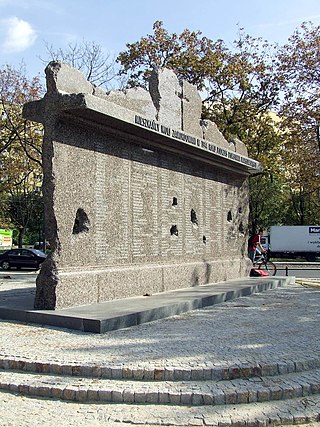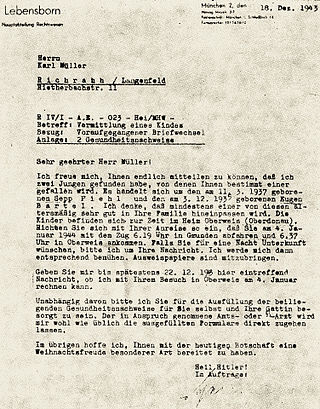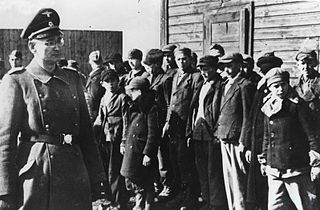
In Nazi German terminology, Volksdeutsche were "people whose language and culture had German origins but who did not hold German citizenship". The term is the nominalised plural of volksdeutsch, with Volksdeutsche denoting a singular female, and Volksdeutsche(r), a singular male. The words Volk and völkisch conveyed the meanings of "folk".

Lebensraum is a German concept of expansionism and Völkisch nationalism, the philosophy and policies of which were common to German politics from the 1890s to the 1940s. First popularized around 1901, Lebensraum became a geopolitical goal of Imperial Germany in World War I (1914–1918), as the core element of the Septemberprogramm of territorial expansion. The most extreme form of this ideology was supported by the Nazi Party and Nazi Germany. Lebensraum was a leading motivation of Nazi Germany to initiate World War II, and it would continue this policy until the end of the conflict.

The Heim ins Reich was a foreign policy pursued by Adolf Hitler before and during World War II, beginning in 1938. The aim of Hitler's initiative was to convince all Volksdeutsche who were living outside Nazi Germany that they should strive to bring these regions "home" into Greater Germany, but also relocate from territories that were not under German control, following the conquest of Poland, in accordance with the Nazi–Soviet pact. The Heim ins Reich manifesto targeted areas ceded in Versailles to the newly reborn state of Poland, various lands of immigration, as well as other areas that were inhabited by significant ethnic German populations, such as the Sudetenland, Danzig, and the southeastern and northeastern regions of Europe after 6 October 1939.

Following the Invasion of Poland at the beginning of World War II, nearly a quarter of the entire territory of the Second Polish Republic was annexed by Nazi Germany and placed directly under the German civil administration. The rest of Nazi-occupied Poland was renamed as the General Government district. The annexation was part of the "fourth partition of Poland" by Nazi Germany and the Soviet Union, outlined months before the invasion, in the Molotov–Ribbentrop Pact.

The Reichsgau Wartheland was a Nazi German Reichsgau formed from parts of Polish territory annexed in 1939 during World War II. It comprised the region of Greater Poland and adjacent areas. Parts of Warthegau matched the similarly named pre-Versailles Prussian province of Posen. The name was initially derived from the capital city, Posen (Poznań), and later from the main river, Warthe (Warta).

The Generalplan Ost, abbreviated GPO, was Nazi Germany's plan for large-scale ethnic cleansing, extermination and genocide of Slavs, Eastern European Jews and other ethnic groups categorised as "Untermensch" in Nazi ideology. The plan was intended to be the precursor for a programme, which would involve the colonisation of Central and Eastern Europe by German settlers, after the elimination of national identities of various Slavic peoples.
Mass evacuation, forced displacement, expulsion, and deportation of millions of people took place across most countries involved in World War II. A number of these phenomena were categorised as violations of fundamental human values and norms by the Nuremberg Tribunal after the war ended. The mass movement of people – most of them refugees – had either been caused by the hostilities, or enforced by the former Axis and the Allied powers based on ideologies of race and ethnicity, culminating in the postwar border changes enacted by international settlements. The refugee crisis created across formerly occupied territories in World War II provided the context for much of the new international refugee and global human rights architecture existing today.
Germanisation, or Germanization, is the spread of the German language, people, and culture. It was a central idea of German conservative thought in the 19th and the 20th centuries, when conservatism and ethnic nationalism went hand in hand. In linguistics, Germanisation of non-German languages also occurs when they adopt many German words.

The German–Soviet population transfers were population transfers of ethnic Germans, ethnic Poles, and some ethnic East Slavs that took place from 1939 to 1941. These transfers were part of the German Heim ins Reich policy in accordance with the German–Soviet Frontier Treaty between Nazi Germany and the Soviet Union.

During World War II, Reichskommissariat Ukraine was the civilian occupation regime of much of Nazi German-occupied Ukraine. It was governed by the Reich Ministry for the Occupied Eastern Territories headed by Alfred Rosenberg. Between September 1941 and August 1944, the Reichskommissariat was administered by Erich Koch as the Reichskommissar. The administration's tasks included the pacification of the region and the exploitation, for German benefit, of its resources and people. Adolf Hitler issued a Führer decree defining the administration of the newly-occupied Eastern territories on 17 July 1941.
The Crimea Germans were ethnic German settlers who were invited to settle in the Crimea as part of the East Colonization.

Crimes against the Polish nation committed by Nazi Germany and Axis collaborationist forces during the invasion of Poland, along with auxiliary battalions during the subsequent occupation of Poland in World War II, consisted of the genocide of millions of Polish people, including the systematic extermination of Jewish Poles. These mass-killings were enacted by the Nazis with further plans that were justified by their racial theories, which regarded Poles and other Slavs, and especially Jews, as racially inferior Untermenschen.
Heimkehr is a 1941 Nazi German anti-Polish propaganda film directed by Gustav Ucicky.

The Deutsche Volksliste, a Nazi Party institution, aimed to classify inhabitants of Nazi-occupied territories (1939-1945) into categories of desirability according to criteria systematised by Reichsführer-SS Heinrich Himmler. The institution originated in occupied western Poland. Similar schemes were subsequently developed in Occupied France (1940-1944) and in the Reichskommissariat Ukraine (1941-1944).

During World War II, Nazi birthing centres for foreign workers, known in German as Ausländerkinder-Pflegestätte, Ostarbeiterkinderpflegestätten, or Säuglingsheim were German institutions used as stations for abandoned infants, Nazi Party facilities established in the heartland of Nazi Germany for the so-called 'troublesome' babies according to Himmler's decree, the offspring born to foreign women and girls servicing the German war economy, including Polish and Eastern European female forced labour. The babies and children, most of them resulting from rape at the place of enslavement, were abducted en masse between 1943 and 1945. At some locations, up to 90 percent of infants died a torturous death due to calculated neglect.

During World War II, around 200,000 ethnic Polish children as well as an unspecified number of children of other ethnicities were abducted from their homes and forcibly transported to Nazi Germany for purposes of forced labour, medical experimentation, or Germanization.

Ostarbeiter was a Nazi German designation for foreign slave workers gathered from occupied Central and Eastern Europe to perform forced labor in Germany during World War II. The Germans started deporting civilians at the beginning of the war and began doing so at unprecedented levels following Operation Barbarossa in 1941. They apprehended Ostarbeiter from the newly-formed German districts of Reichskommissariat Ukraine, District of Galicia, and Reichskommissariat Ostland. These areas comprised German-occupied Poland and the conquered territories of the Soviet Union. According to Pavel Polian, over 50% of Ostarbeiters were formerly Soviet subjects originating from the territory of modern-day Ukraine, followed by Polish women workers. Eastern workers included ethnic Ukrainians, Poles, Belarusians, Russians, Armenians, Tatars, and others. Estimates of the number of Ostarbeiter range between 3 million and 5.5 million.

Heuaktion was a World War II operation in which 40,000 to 50,000 Polish children aged 10 to 14 were kidnapped by German occupation forces and transported to Nazi Germany as slave labourers.

The Expulsion of Poles by Nazi Germany during World War II was a massive operation consisting of the forced resettlement of over 1.7 million Poles from the territories of German-occupied Poland, with the aim of their Germanization between 1939 and 1944.
In Nazi Germany, the state gave a number of honorary titles to certain German cities. Not included in this list is the Polish city of Zamość, which, in 1942, was planned to be renamed Himmlerstadt, after Heinrich Himmler.














